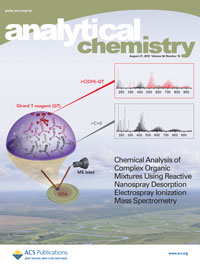| Nov 24, 2012 | |
Nano-DESI takes active approach to understanding complexity |
|
| (Nanowerk News) A tool for characterizing molecules in minute samples with no time-consuming or destructive sample preparation, nano-DESI is now more versatile, thanks to scientists at the Pacific Northwest National Laboratory and the University of California, Irvine(Offsite link). They showed how to use the new ionization technique to selectively analyze and quantify molecules of interest in a complex mixture. This research graced the cover of Analytical Chemistry ("Chemical Analysis of Complex Organic Mixtures Using Reactive Nanospray Desorption Electrospray Ionization Mass Spectrometry"). | |
 Conducting reactive analysis on complex organic aerosol samples using nano-DESI was featured on the cover of Analytical Chemistry. This new technique, demonstrated for the first time at DOE's EMSL, enables scientists to discover exactly how much of a certain compound exists in a sample. The cover artwork was done by Nathan Johnson and Alexander Laskin. "We are working with complex mixtures. Analyzing such systems, whether they are on the surface of a catalyst, a microbial community, or atmospheric aerosols, and understanding their impact requires tools that can accurately identify and quantify hundreds of molecules," said Dr. Julia Laskin, a PNNL chemist, who has been advancing the frontiers of the Nanospray Desorption Electrospray Ionization Mass Spectrometry, nicknamed nano-DESI, for the last 3 years. Why It Matters Without understanding the reactions that occur in complex molecular mixtures, whether they are in new biofuels, small ambient particles, or car exhaust, improvements and innovations are difficult at best. Understanding requires new tools capable of sensitive measurements and analysis. Because of the costs and resources involved in scientific discovery, these tools must be quick, accurate, and cost effective. "Because nano-DESI already meets this trio of requirements in passive mode, the reactive mode is another valuable tool in understanding the complex chemical world around us," said Dr. Alexander Laskin, an EMSL scientist who conducted numerous experiments using the reactive nano-DESI approach. |
|
| Methods | |
| In this new approach, the team began with an atmospheric aerosol sample that contains thousands of molecules formed in the reactions of ozone, a common atmospheric oxidant, with limonene, a molecule emitted by various types of trees, which is responsible for the citrus scent found walking among the orange trees. The team reacted limonene with ozone, creating aerosols. They collected the aerosols on a surface, or substrate, and then added Girard’s reagent T to the nano-DESI solvent. | |
| The reagent selectively targets molecules that contain carbonyl groups. A carbonyl group, a carbon atom double bonded to an oxygen atom, is among the most active groups in organic chemistry. The reagent's targeting the carbonyl group modifies these molecules such that they become charged and are therefore readily detected by mass spectrometry. | |
| The team determined that in the aerosol mixture, certain compounds reacted to form an adduct, which is the molecule that formed a bond with the reagent. By varying the amount of reagent in the solvent, the researchers found that the most abundant dimer was detected at the ~0.5-picogram level. The total amount of dimers and trimers packed in the sample was about 11 picograms. To put this analyzed weight in perspective, it is 1,000,000,000,000 times smaller than the weight of one sip of coffee. | |
| "Reactive nano-DESI enables unique experimental capability for selective detection and quantitative estimation of targeted individual molecules present in complex environmental samples containing thousands of individual species," said Alexander Laskin. | |
| "The research opens up opportunities for using different reagents in nano-DESI, allowing for detailed analysis of different classes of compounds in bewilderingly complex mixtures," said Dr. Sergey A. Nizkorodov, an Associate Professor of chemistry at University of California, Irvine. | |
| What's Next | |
| The research showed that by varying the concentration of the reagent, scientists can determine the concentrations of hundreds of molecules in a complex mixture without knowing much about the molecules in advance, other than the fact that they possess a certain chemical group. For researchers working with biofuels, petroleum chemistry, aerosols, and other environmental samples where large collections of unidentified molecules are the norm, this information is going to be tremendously valuable. | |
| "Our work with limonene-derived aerosols is only the first step. The door is just opening for reactive nano-DESI studies that will advance our understanding chemistry in complex environments," said Julia Laskin. |
| Source: Pacific Northwest National Laboratory |
